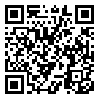Articles accepted at the time of publication
Back to the articles list |
Back to browse issues page
1- Tarbiat Modares University , m.afshar@modares.ac.ir
2- Tarbiat Modares university
2- Tarbiat Modares university
Abstract: (2177 Views)
The present study aims to investigate the distribution of meaning in the narrative space of Abu Torab Khosravi's novel "Rood Ravi" drawing on the views of Yuri Lotman (1922-1993), a prominent semiotician and founder of the Tartu-Moscow School of Semiotics. Lotman posits that active sign systems within specific social and geographical contexts derive their significative power from their interaction with a large body of signs present in the collective memory of the people of that context. In his book “Universe of the Mind” (Lotman, 1990), he refers to this conglomeration of signs as the "semiosphere," which he characterizes by features such as boundary, heterogeneity, and centrality. According to Lotman, significative density within the semiosphere is not uniform, and the density of meaning increases as one moves from peripheral regions to the center with cultural meta-structures charging more elements with meanings in the central regions. The study adopts a descriptive-analytical approach to investigate how temporal-spatial elements and character actions acquire meaning in the narrative space as the story progresses towards the center of Dar al-Miftah. The findings suggest that cultural meta-structures load more elements with signification in the central regions, resulting in a higher concentration of meanings in these areas.
Article Type: مقالات علمی پژوهشی |
Subject:
Semiotics
Send email to the article author
| Rights and permissions | |
 |
This work is licensed under a Creative Commons Attribution-NonCommercial 4.0 International License. |







